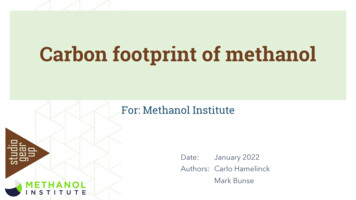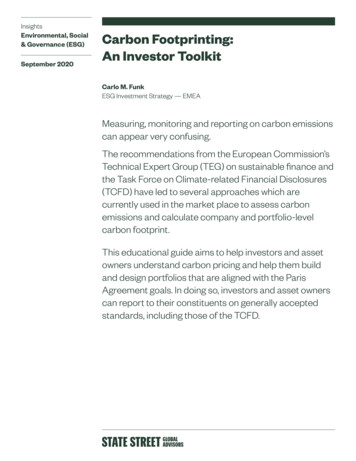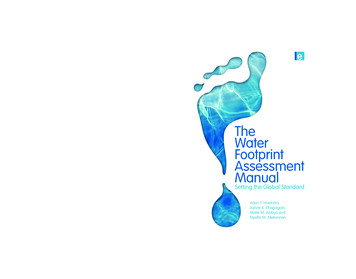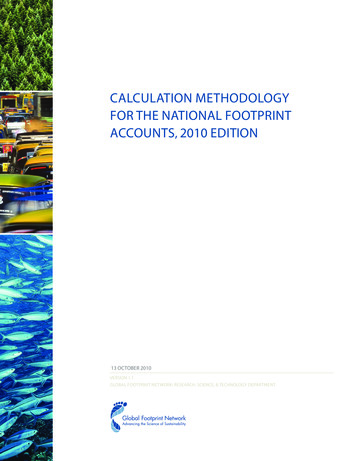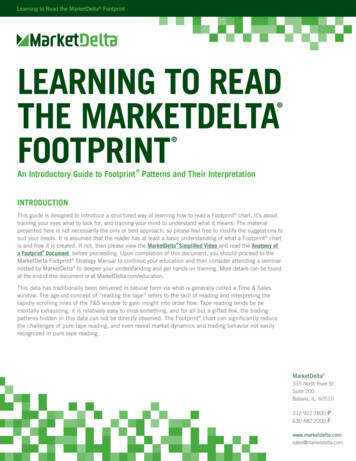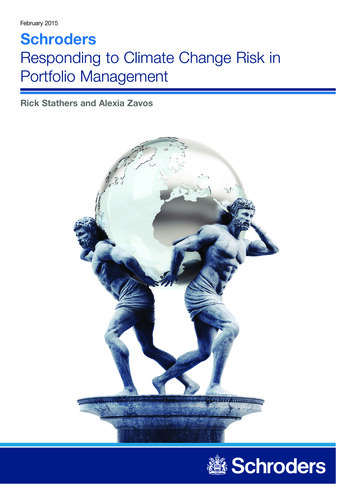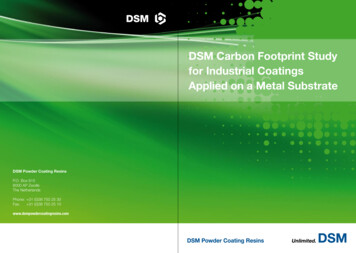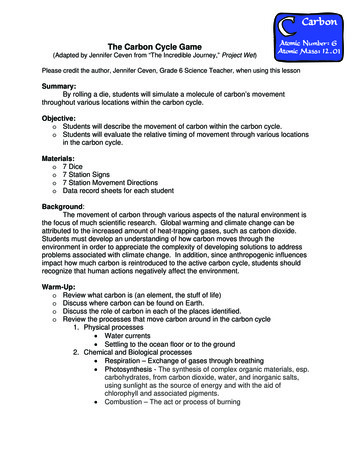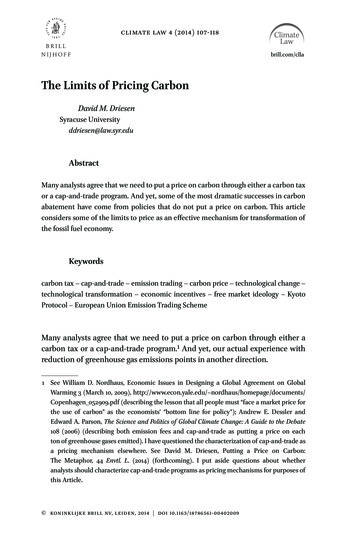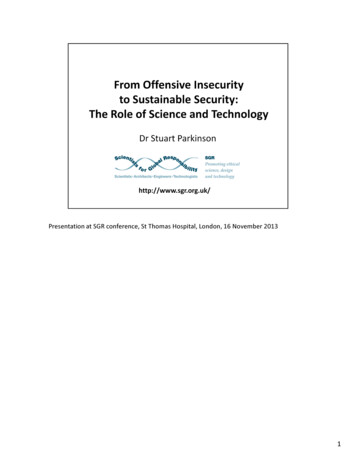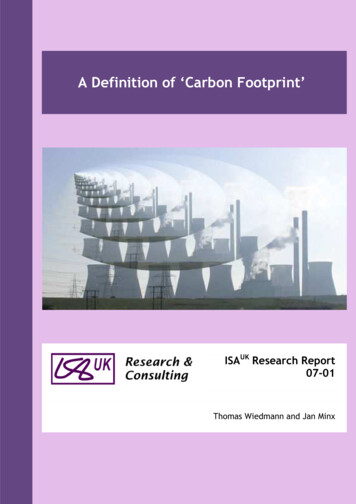
Transcription
ISAUK Research Report 07-010A Definition of ‘Carbon Footprint’ISAUK Research Report07-01Thomas Wiedmann and Jan Minx
ISAUK Research Report 07-01 June 2007ISAUK Research & Consulting35 Boundary CloseDurham, DH7 7FBUnited KingdomE: info@isa-research.co.ukW: www.isa-research.co.uk, www.isa.org.usyd.edu.au
ISAUK Research Report 07-011ISAUK Research Report07-01available at www.isa-research.co.ukA Definition of 'Carbon Footprint'Thomas Wiedmann1)*) and Jan Minx2)1) ISAUK Research & Consulting, Durham, DH7 7FB, UK (www.isa-research.co.uk)2) Stockholm Environment Institute, University of York, Heslington, York, YO10 5DD, UK (www.sei.se)*) Corresponding author. Email: tommy@isa-research.co.ukAbstractThe term ‘carbon footprint’ has become tremendously popular over the last few years and is now inwidespread use across the media – at least in the United Kingdom. With climate change high up on thepolitical and corporate agenda, carbon footprint calculations are in strong demand. Numerous approacheshave been proposed to provide estimates, ranging from basic online calculators to sophisticated life-cycleanalysis or input-output-based methods and tools. Despite its ubiquitous use however, there is an apparentlack of academic definitions of what exactly a ‘carbon footprint’ is meant to be. The scientific literature issurprisingly void of clarifications, despite the fact that countless studies in energy and ecological economicsthat could have claimed to measure a ‘carbon footprint’ have been published over decades.This report explores the apparent discrepancy between public and academic use of the term ‘carbonfootprint’ and suggests a scientific definition based on commonly accepted accounting principles andmodelling approaches. It addresses methodological question such as system boundaries, completeness,comprehensiveness, units and robustness of the indicator.Keywordscarbon footprint, ecological footprint, indirect carbon emissions, indicators, environmental accounting,input-output analysis, life-cycle analysis, hybrid analysis
ISAUK Research Report 07-012Introduction‘Carbon footprint’ has become a widely used termand concept in the public debate on responsibilityand abatement action against the threat of globalclimate change. It had a tremendous increase inpublic appearance over the last few months andyears and is now a buzzword widely used acrossthe media, the government and in the businessworld.embodied in upstream production processes orwhether it is sufficient to look at just the direct, onsite emissions of the product, process or personunder consideration. In other words, should thecarbon footprint reflect all life-cycle impacts ofgoods and services used? If yes, where should theboundary be drawn and how can these impacts bequantified?But what exactly is a ‘carbon footprint’? Despite itsubiquitous appearance there seems to be no cleardefinition of this term and there is still someconfusion what it actually means and measuresand what unit is to be used. While the term itself isrooted in the language of Ecological Footprinting(Wackernagel 1996), the common baseline is thatthe carbon footprint stands for a certain amount ofgaseous emissions that are relevant to climatechange and associated with human production orconsumption activities. But this is almost wherethe commonality ends. There is no consensus onhow to measure or quantify a carbon footprint. Thespectrum of definitions ranges from direct CO2emissions to full life-cycle greenhouse gasemissions and not even the units of measurementare clear.Finally, the term ‘footprint’ seems to suggest ameasurement (expression) in area-based units.After all, a linguistically close relative, the‘Ecological Footprint’ is expressed (measured) inhectares or 'global hectares'. This question,however, has even more far-reaching implicationsas it goes down to the very decision whether thecarbon footprint should be a mere ‘pressure’indicator expressing (just) the amount of carbonemissions (measured e.g. in tonnes) or whether itshould indicate a (mid-point) impact, quantified intonnes of CO2 equivalents (t CO2-eq.) if the impactis global warming potential, or in an area-basedunit if the impact is ‘land appropriation’.Questions that need to be asked are: Should thecarbon footprint include just carbon dioxide (CO2)emissions or other greenhouse gas emissions aswell, e.g. methane? Should it be restricted tocarbon-based gases or can it include substancesthat don’t have carbon in their molecule, e.g. N2O,another powerful greenhouse gas? One could evengo as far as asking whether the carbon footprintshould be restricted to substances with agreenhouse warming potential at all. After all,there are gaseous emissions such as carbonmonoxide (CO) that are based on carbon andrelevant to the environment and health. What'smore, CO can be converted into CO2 throughchemical processes in the atmosphere. Also,should the measure include all sources ofemissions, including those that do not stem fromfossil fuels, e.g. CO2 emissions from soils?A very central question is whether the carbonfootprint needs to include indirect emissionsMany of these questions have been discussed inthe disciplines of ecological economics and lifecycle assessment for many years and thereforesome answers are at hand. So far, however, theyhave not been applied to the term carbon footprintand thus a clear definition is currently missing.This report addresses the questions above andattempts a clarification. We provide a literatureoverview, propose a working definition of theterm 'carbon footprint' and discuss methodologicalimplications.A brief literature reviewA literature search in June 2007 for the term"carbon footprint" (i.e. where these two wordsstand next to each other in this order) in allscientific journals and all search fields covered byScopus 1 and ScienceDirect 2 for the years 1960 to1Scopus (www.scopus.com) is currently the largestabstract and citation database of peer-reviewed
ISAUK Research Report 07-012007 yielded 42 hits; 3 from the year 2005, 8 from2006 and 31 from 2007. Most articles deal with thequestion of how much carbon dioxide emissionscan be attributed to a certain product, company ororganisation, although none of them provides an3unambiguous definition of the term carbonfootprint.In most cases 'carbon footprint' is used as a genericsynonym for emissions of carbon dioxide orgreenhouse gases expressed in CO2 equivalents.Table 1: Definitions of 'carbon footprint' from the grey literatureSourceDefinitionBP (2007)"The carbon footprint is the amount of carbon dioxide emitted due to your dailyactivities – from washing a load of laundry to driving a carload of kids to school."British SkyBroadcasting(Sky) (Patel 2006)The carbon footprint was calculated by "measuring the CO2 equivalent emissions fromits premises, company-owned vehicles, business travel and waste to landfill." (Patel2006)Carbon Trust(2007)" a methodology to estimate the total emission of greenhouse gases (GHG) in carbonequivalents from a product across its life cycle from the production of raw materialused in its manufacture, to disposal of the finished product (excluding in-useemissions)." a technique for identifying and measuring the individual greenhouse gas emissionsfrom each activity within a supply chain process step and the framework forattributing these to each output product (we [The Carbon Trust] will refer to this as theproduct’s ‘carbon footprint’)." (CarbonTrust 2007, p.4)Energetics (2007)" the full extent of direct and indirect CO2 emissions caused by your businessactivities."ETAP (2007)" the ‘Carbon Footprint’ is a measure of the impact human activities have on theenvironment in terms of the amount of greenhouse gases produced, measured intonnes of carbon dioxide."Global FootprintNetwork (2007)"The demand on biocapacity required to sequester (through photosynthesis) thecarbon dioxide (CO2) emissions from fossil fuel combustion." (GFN 2007; see also text)Grub & Ellis(2007)"A carbon footprint is a measure of the amount of carbon dioxide emitted through thecombustion of fossil fuels. In the case of a business organization, it is the amount ofCO2 emitted either directly or indirectly as a result of its everyday operations. It alsomight reflect the fossil energy represented in a product or commodity reachingmarket."PaliamentaryOffice of Scienceand Technology(POST 2006)"A ‘carbon footprint’ is the total amount of CO2 and other greenhouse gases, emittedover the full life cycle of a process or product. It is expressed as grams of CO2equivalent per kilowatt hour of generation (gCO2eq/kWh), which accounts for thedifferent global warming effects of other greenhouse gases."research literature. Scopus is updated daily andcovers 30 million abstracts of 15,000 peer-reviewedjournals from more than 4,000 publishers ensuring abroad interdisciplinary coverage.2ScienceDirect (www.sciencedirect.com) contains over25% of the world's science, technology and medicinefull text and bibliographic information, including ajournal collection of over 2,000 titles as well as onlinereference works, handbooks and book series.Some articles, however, discuss the implications ofprecise wording. Geoffrey Hammond writes(Hammond 2007): " The property that is oftenreferred to as a carbon footprint is actually a'carbon weight' of kilograms or tonnes per personor activity." Hammond argues " that those whofavour precision in such matters should perhapscampaign for it to be called 'carbon weight', orsome similar term."
ISAUK Research Report 07-01Haven (2007) mentions the carbon footprintanalysis of an office chair as a "life-cycleassessment which took into account materials,manufacture, transport, use and disposal at everystage of development." 3 This hints at a morecomprehensive approach, rarely described in otherarticles. However, there is no definition ormethodological description. Eckel (2007) points outthat the "Assessment of a business' carbonfootprint is not just calculating energyconsumption but also with increasing every scrapof data from every aspect of the businesspractices." Again, no clear scope of analysis isprovided.While academia has largely neglected thedefinition issue, consultancies, businesses, NGOsand government have moved forward themselvesand provided their own definitions. In the greyliterature is a plethora of descriptions, some ofwhich are presented in Table 1.In the UK, the Carbon Trust 4 has aimed atdeveloping a more common understanding what acarbon footprint of a product is and circulated adraft methodology for consultation (Carbon Trust2007, see definition in Table 1). It is emphasisedthat only input, output and unit processes whichare directly associated with the product should beincluded, whilst some of the indirect emissions –e.g. from workers commuting to the factory – arenot factored in.Life-cycle thinking can be found in many otherdocuments and seem to have developed into onecharacteristic of carbon footprint estimates. Astandardisation process has been initiated by theCarbon Trust and Defra aimed at developing aPublicly Available Specification (PAS) for LCAmethodology used by the Carbon Trust to measure34Note that a carbon footprint of a product derived insuch a way cannot just be added to the carbonfootprint of an office using this chair as this wouldlead to double counting. Furthermore, double (ormultiple) counting would occur if companiesinvolved in the life cycle chain of the chair(manufacturing, transport, disposal) reported theirfull emissions (see e.g. Hammerschlag and Barbour2003, Lenzen 2007 and Lenzen et al. 2007).The Carbon Trust is a private company set up by theUK government "to accelerate the transition to a lowcarbon economy."4the embodied greenhouse gases in products(DEFRA 2007). Below, we discuss the pro's andcon's of various methodologies.The Global Footprint Network, an organisationthat compiles 'National Footprint Accounts' on anannual basis (Wackernagel et al. 2005) sees thecarbon footprint as a part of the EcologicalFootprint. Carbon footprint is interpreted as asynonym for the 'fossil fuel footprint' or thedemand on 'CO2 area' or 'CO2 land'. The latter oneis defined as "The demand on biocapacity requiredto sequester (through photosynthesis) the carbondioxide (CO2) emissions from fossil fuelcombustion. [It] includes the biocapacity,typically that of unharvested forests, needed toabsorb that fraction of fossil CO2 that is notabsorbed by the ocean." However, whileindividual documents have used such a landbased definition, for example the Scottish ClimateChange Strategy (see Scottish Executive 2006), ithas not changed the common understanding of thecarbon footprint as a measure of carbon dioxideemissions or carbon dioxide equivalents in theliterature.A definition of 'carbon footprint'We propose the following definition of the term'carbon footprint':"The carbon footprint is a measure of theexclusive total amount of carbon dioxideemissions that is directly and indirectly causedby an activity or is accumulated over the lifestages of a product."This includes activities of individuals, populations,governments, companies, organisations, processes,industry sectors etc. Products include goods andservices. In any case, all direct (on-site, internal)and indirect emissions (off-site, external,embodied, upstream, downstream) need to betaken into account.The definition provides some answers to thequestions posed at the beginning. We include onlyCO2 in the analysis, being well aware that there areother substances with greenhouse warming
ISAUK Research Report 07-01potential. However, many of those are either notbased on carbon or are more difficult to quantifybecause of data availability. Methane could easilybe included, but what information is gained from apartially aggregated indicator, that includes justtwo of a number of relevant greenhouse gases? Acomprehensive greenhouse gas indicator shouldinclude all these gases and could for example betermed 'climate footprint'. In the case of 'carbonfootprint' we opt for the most practical and clearsolution and include only CO2.The definition also refrains from expressing thecarbon footprint as an area-based indicator. The'total amount' of CO2 is physically measured inmass units (kg, t, etc) and thus no conversion to anarea unit (ha, m2, km2, etc) takes place. Theconversion into a land area would have to bebased on a variety of different assumptions andincreases the uncertainties and errors associatedwith a particular footprint estimate (see e.g.Lenzen 2006). For this reason accountants usuallytry to avoid unnecessary conversions and attemptto express any phenomenon in the mostappropriate measurement unit (e.g. Keuning 1994;Stahmer 2000). Following this rationale a landbased measure does not seem appropriate and weprefer the more accurate representation in tonnesof carbon dioxide.Whilst it is important for the concept of 'carbonfootprint' to be all-encompassing and to include allpossible causes that give rise to carbon emissions,it is equally important to make clear what thisincludes. The correct measurement of carbonfootprints gains a particular importance andprecariousness when it comes to carbon offsetting.It is obvious that a clear definition of scope andboundaries is essential when projects to reduce orsequester CO2 emissions are sponsored. Whenaccounting for indirect emissions, methodologiesneed to be applied that avoid under-counting aswell as double-counting of emissions, therefore theword 'exclusive' in the definition.5 Furthermore, afull life-cycle assessment of products means that allthe stages of this life cycle need to be evaluatedcorrectly (with “full” meaning “untruncated”). Inthefollowingsectionwediscussthemethodological implications of these requirements.5Compare with the discussion of 'shared reponsibility'as outlined by Lenzen et al. (2007).5Methodological issuesThe task of calculating carbon footprints can beapproached methodologically from two differentdirections: bottom-up, based on Process Analysis(PA) or top-down, based on Environmental InputOutput (EIO) analysis. Both methodologies need todeal with the challenges outlined above and striveto capture the full life cycle impacts, i.e. inform afull Life Cycle Analysis/Assessment (LCA). Here,only a brief impression of some of their mainmerits and drawbacks can be provided.Process analysis (PA) is a bottom-up method,which has been developed to understand theenvironmental impacts of individual productsfrom cradle to grave. The bottom-up nature of PALCAs (process-based LCAs) means that they sufferfrom a system boundary problem - only on-site,most first-order, and some second-order impactsare considered (Lenzen 2001). If PA-LCAs are usedfor deriving carbon footprint estimates, a strongemphasis therefore needs to be given to theidentification of appropriate system boundaries,which minimise this truncation error. PA-basedLCAs run into further difficulties once carbonfootprints for larger entities such as government,households or particular industrial sectors have tobe established. Even though estimates can bederived by extrapolating information contained inlife-cycle databases, results will get increasinglypatchy as these procedures usually require theassumption that a subset of individual productsare representative for a larger product groupingand the use of information from differentdatabases, which are usually not consistent (seee.g. Tukker and Jansen 2006).Environmental input-output (EIO) analysisprovides an alternative top-down approach tocarbon footprinting (see e.g. Wiedmann et al.2006). Input-output tables are economic accountsproviding a picture of all economic activities at themeso (sector) level. In combination with consistentenvironmental account data they can be used toestablish carbon footprint estimates in acomprehensive and robust way taking intoaccount all higher order impacts and setting thewhole economic system as boundary. However,this completeness comes at the expense of detail.The suitability of environmental input-output
ISAUK Research Report 07-01analysis to assess micro systems such as productsor processes is limited, as it assumes homogeneityof prices, outputs and their carbon emissions at thesector level. Although sectors can be disaggregatedfor further analysis, bringing it closer to a microsystem, this possibility is limited, at least on alarger scale. A big advantage of input-outputbased approaches, however, is a much smallerrequirement of time and manpower once themodel is in place.The best option for a detailed, yet comprehensiveand robust analysis is to combine the strength ofboth methods by using a hybrid approach (Bullardet al. 1978, Suh et al. 2004, Heijungs and Suh 2006),where the PA and input-output methodologies areintegrated. Such an approach allows to preservethe detail and accuracy of bottom-up approachesin lower order stages, while higher-orderrequirements are covered by the input-output partof the model. Such a Hybrid-EIO-LCA method,embedding process systems inside input-outputtables, is the current state-of-the art in ecologicaleconomic modelling (Heijungs and Suh 2002,Heijungs et al. 2006, Heijungs and Suh 2006). Theliterature is just emerging and few practitioners sofar have acquired the skills to carry out such ahybrid assessment. However, rapid progress andmuch improved models can be expected over thenext few years.The method of choice will often depend on thepurpose of the enquiry and the availability of dataand resources. It can be said that environmentalinput-output analysis is superior for theestablishment of carbon footprints in macro andmeso systems. In this context a carbon footprint ofindustrial sectors, individual businesses, largerproduct groups, households, government, theaverage citizen or an average member of aparticular socio-economic group can easily beperformed by input-output analysis (e.g. Foran etal. 2005, SEI et al. 2006, Wiedmann et al. 2007).Process analysis has clear advantages for lookingat micro systems: a particular process, an6individual product or a relatively small group ofindividual products.Practical examplesTo date carbon footprints have been established forcountries and sub-national regions (SEI and WWF2007), institutions such as schools (GAP et al.2006), products (Carbon Trust 2006), businessesand investment funds (Trucost 2006).In this section we present two practical examplesof a carbon footprint analysis that adhere to thedefinition suggested above. Both analyses wereundertaken by researchers of the StockholmEnvironment Institute at the University of York,employing an input-output based approach.The 'UK Schools Carbon Footprint Scoping Study'(GAP et al. 2006) estimates that all schools in theUnited Kingdom had a carbon footprint of 9.2million tonnes of carbon dioxide in 2001, equatingto 1.3% of total UK emissions. Only around 26% ofthis total carbon footprint can be attributed to onsite emissions from the heating of premises,whereas the other three quarters are from indirectemission sources, such as electricity (22%), schooltransport (14%), other transport (6%), chemicals(5%), furniture (5%), paper (4%), othermanufactured products (14%), mining andquarrying (2%) and other products and services(3%).The second example is a calculation of the carbonfootprint of UK households, taking into accountdirect and indirect emissions occurring on UKterritory due to consumption activities of UKresidents as well as the (indirect) emissions that areembodied in imports to the UK. The results,presented in the 'Counting Consumption' report(SEI et al. 2006), suggest that the carbon footprintof an average UK household was 20.7 tonnes ofCO2 in 2001. A breakdown of this total is presentedin Figure 1.
ISAUK Research Report 07-017Private cars20Direct fuel use in the homeElectricity in the home15Aviation and public transportRecreation, leisure and tourismFood, drink and catering10Household appliancesClothing and footwearHealth, hygiene and education5Other goodsOther services-Figure 1:Carbon dioxide emissions associated with UK household consumption in 2001(tonnes of CO2 per household) (SEI et al. 2006)Direct emissions occur through heating and caruse. Indirect emissions are the emissions that occurduring the generation of electricity and theproduction of goods and services (whether theyare produced in the UK or in other countries).They make up 70 per cent of the almost 21 tonnesof CO2 per household. Transport (private cars,aviation and public transport) accounts for 28% oftotal emissions. Electricity use in the home and useof fuels for space and water heating in the homeaccount for almost one third of the emissions.These findings have also been published by the UKDepartment for the Environment, Food and RuralAffairs (DEFRA) in the 'The Environment in yourPocket' publication (DEFRA 2006).ConclusionsA review of scientific literature, publications andstatements from the public and private sector aswell as general media suggests that the term'carbon footprint' has become widely established inthe public domain albeit without being clearlydefined in the scientific community. In this reportwe suggest a definition of the term 'carbonfootprint' and hope to stimulate an academicdebate about the concept and process of carbonfootprint assessments.We argue that it is important for a 'carbonfootprint' to include all direct as well as indirectCO2 emissions, that a mass unit of measurementshould be used, and that other greenhouse gasesshould not be included (or otherwise the indicatorshould be termed 'climate footprint'). We discussthe appropriateness of two major methodologies,process analysis and input-output analysis, findingthat the latter one is able to providecomprehensive and robust carbon footprintassessments of production and consumptionactivities at the meso level. As an appropriatesolution for the assessment of micro-systems suchas individual products or services we suggest aHybrid-EIO-LCA approach, where life-cycleassessments are combined with input-outputanalysis. In this approach, on-site, first- andsecond-order process data on environmentalimpacts is collected for the product or servicesystem under study, while higher-order requirements are covered by input-output analysis.6Whatever method is used to calculate carbonfootprints it is important to avoid double-countingalong supply chains or life cycles. This is becausethere are significant implications on the practicesof carbon trading and carbon offsetting(Hammerschlag and Barbour 2003, Lenzen 2007,Lenzen et al. 2007).6For example by using the Bottomline3 tool(see www.bottomline3.co.uk).
ISAUK Research Report 07-01ReferencesBP (2007), What is a Carbon Footprint?, Internet site:http://www.bp.com/liveassets/bp internet/globalbp/STAGING/global assets/downloads/A/ABP ADVwhat on earth is a carbon footprint.pdfBullard, C.W., Penner, P.S. and Pilati, D.A. (1978). "Netenergy analysis: Handbook for combining processand input-output analysis". Resources and Energy1(3): 267-313. on Trust (2006) "Carbon footprints in the supplychain: the next step for business". Report NumberCTC616, November 2006, The Carbon Trust,London, UK. http://www.carbontrust.co.uk.Carbon Trust (2007) "Carbon Footprint MeasurementMethodology, Version 1.1". 27 February 2007, TheCarbon Trust, London, UK.http://www.carbontrust.co.uk.DEFRA (2006). "The Environment in Your Pocket".Department for Environment, Food and RuralAffairs, ics/eiyp/index.htm.DEFRA (2007). "Step forward on reducing climatechange impacts from products." DEFRA press release,30 May 2007, Eckel, A. (2007). Gravure 21(2): 35-36.Energetics (2007). The Reality of Carbon Neutrality,London.www.energetics.com.au/file?node id 21228ETAP (2007). The Carbon Trust Helps UK BusinessesReduce their Environmental Impact, Press jan07 carbon trust initiative.pdfForan, B., Lenzen, M. and Dey, C. (2005). "Balancing Act:A triple bottom line analysis of the 135 sectors of theAustralian economy". CSIRO Resource Futures andThe University of Sydney, Canberra, ACT,Australia. www.cse.csiro.au/research/balancingactGAP, SEI and Eco-Logica (2006). "UK Schools CarbonFootprint Scoping Study". Report by Global ActionPlan, Stockholm Environment Institute and EcoLogica Ltd for the Sustainable DevelopmentCommission, London, March 2006. http://www.sdcommission.org.uk/publications.php?id 389.GFN (2007). "Ecological Footprint Glossary". GlobalFootprint Network, Oakland, CA, USA. AccessedJuly 2007 from8http://www.footprintnetwork.org/gfn sub.php?content glossary.Grubb and Ellis (2007). Meeting the Carbon Challenge:The Role of Commercial Real Estate Owners, Users& Managers, Chicago.Hammerschlag, R. and Barbour, W. (2003). "Life-CycleAssessment and Indirect Emission Reductions:Issues Associated with Ownership and Trading".Institute for Lifecycle Environmental Assessment(ILEA), Seattle, Washington, USA, May ons.pdf.Hammond, G. (2007). "Time to give due weight to the'carbon footprint' issue". Nature 445(7125): 256.http://dx.doi.org/10.1038/445256b.Haven, J. (2007). Environment Business 129: 27.Heijungs, R. and Suh, S. (2002). The computationalstructure of life cycle assessment. Kluwer AcademicPublishers, Dordrecht, The Netherlands.Heijungs, R. and Suh, S. (2006). "Reformulation ofmatrix-based LCI: from product balance to processbalance". Journal of Cleaner Production 14(1): 022.Heijungs, R., de Koning, A., Suh, S. and Huppes, G.(2006). "Toward an Information Tool for IntegratedProduct Policy: Requirements for Data andComputation". Journal of Industrial Ecology 10(3):147-158. ng, S.J. (1994). The SAM and Beyond: OpenSESAME!, Economic Systems Research 6(1): 21-50.Lenzen, M. (2001). "Errors in Conventional and InputOutput-based Life-Cycle Inventories". Journal ofIndustrial Ecology 4(4): 1.Lenzen, M. (2006). "Uncertainty in Impact andExternality Assessments - Implications for DecisionMaking (13 pp)". The International Journal of LifeCycle Assessment 11(3): enzen, M. (2007). "Double-counting in Life-CycleAssessment". Journal of Industrial Ecology:submitted.Lenzen, M., Murray, J., Sack, F. and Wiedmann, T.(2007). "Shared producer and consumerresponsibility - Theory and practice". EcologicalEconomics 61(1): .018.POST (2006) "Carbon footprint of electricity generation".POSTnote 268, October 2006, Parliamentary Officeof Science and Technology, London, n268.pdf.
ISAUK Research Report 07-01Patel, J. (2006). "Green sky thinking". EnvironmentBusiness(122): 32.Scottish Executive (2006). Changing Our Ways:Scotland's Climate Change Programme, Edinburgh.SEI and WWF (2007). The Carbon Footprints of LocalAuthorities in England, forthcoming.SEI, WWF and CURE (2006). "Counting Consumption CO2 emissions, material flows and EcologicalFootprint of the UK by region and devolvedcountry". Published by WWF-UK, Godalming,Surrey, UK, 2006.http://www.ecologicalbudget.org.uk.Stahmer, C. (2000). The magic triangle of input-output,Paper presented at the XIII International Conferenceon Input-Output Techniques, 21-25 August,Macerata, Italy.Suh, S., Lenzen, M., Treloar, G.J., Hondo, H., Horvath,A., Huppes, G., Jolliet, O., Klann, U., Krewitt, W.,Moriguchi, Y., Munksgaard, J. and Norris, G. (2004)."System boundary selection in life-cycle inventoriesusing hybrid approaches". Environmental Science &Technology 38(3): 657-664.Trucost (2006), Carbon Counts: The Trucost CarbonFootprint Ranking of UK Investmen
ISA UK Research Report 07-01 1 ISA UK Research Report 07-01 available at www.isa-research.co.uk A Definition of 'Carbon Footprint' Thomas Wiedmann 1)*) and Jan Minx 2) 1) ISA UK Research & Consulting, Durham, DH7 7FB, UK (www.isa-research.co.uk ) 2) Stockholm Environment Institute, University of York, Heslington, York, YO10 5DD, UK (www.sei.se )
